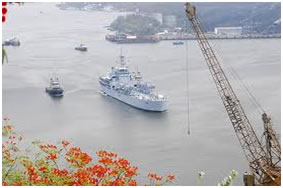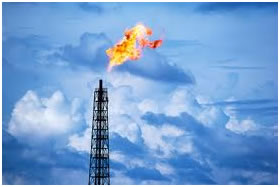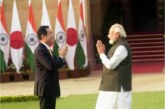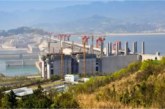[Spurred by a decade-long economic boom, India’s ever-growing appetite for energy is quietly reshaping the way it operates in the world, changing relations with its neighbors, extending its reach to oil states as far flung as Sudan and Venezuela, and overcoming Washington’s resistance to its nuclear ambitions.]
Hovering over India’s energy quest is its biggest competitor: China, which is also scouring the globe to line up new energy sources. The combined appetite of the two Asian giants is raising oil prices and putting greater demands on world oil supplies.
Already India’s energy ambitions have led to developments unthinkable just a few years ago: a proposed pipeline to ferry natural gas from Iran across Pakistan; a new friendship with the military government in gas-rich Myanmar; and budding talks with the United States to let India buy nuclear technology.
Indeed, ‘mutual dependencies’ is the buzzword of the day, signaling the way oil and gas links among South Asian countries stand to rewrite the enmities of the past. According to Ashutosh Varshney, a political scientist at the University of Michigan, “The foreign policy of India will have a lot to do with energy, which is a new imagination and one likely to stay.”
That vision is not without its challenges. On the one hand, India seeks to cast itself as the model of democratic pluralism, as in its bid for a permanent seat on the United Nations Security Council. On the other, its hunt for fuel is pushing it to reach out to authoritarian governments like those of Sudan and Myanmar, which the United States has sought to isolate. In both of those countries, China’s weight is also keenly felt.
 But India is quickly making inroads. It has persuaded a wary Bangladesh to agree, at least in principle, to a pipeline that would ship gas from Myanmar to India. The Indian officials have been shuttling to Saudi Arabia, India’s largest oil supplier, to persuade it to invest in Indian oil and gas projects, among other things. India has also sought to lure foreign investors to explore for reserves in the Bay of Bengal, off India’s eastern coast – what he calls “the North Sea of South Asia.”
But India is quickly making inroads. It has persuaded a wary Bangladesh to agree, at least in principle, to a pipeline that would ship gas from Myanmar to India. The Indian officials have been shuttling to Saudi Arabia, India’s largest oil supplier, to persuade it to invest in Indian oil and gas projects, among other things. India has also sought to lure foreign investors to explore for reserves in the Bay of Bengal, off India’s eastern coast – what he calls “the North Sea of South Asia.”
As energy is the main driving force of India’s economic growth, its availability with required quality of supply is key to sustainable development. The commercial energy has a direct impact and influence on the quality of service in various socio-economic fields and inadequate energy supply can adversely affect these vital and essential requirements of the society. Thus, it is essential to augment significantly the energy availability at a rapid pace so that aspirations of those who have remained insulated from such important inputs and services are fulfilled and they are enabled to have a reasonable access.
With a population of over one billion, India is the world’s second most populous country and ranks fifth in the world in terms of primary energy consumption, accounting for about 3.5 per cent of the world’s commercial energy demand. With an average GDP growth rate of around 8%, India is currently one of the fastest growing economies of the world. The future levels and patterns of energy use in India, therefore, have important implications – at the national level in terms of environmental impacts of energy use, issues of access and equity, and at the global level in terms of geopolitics of energy supply and GHG emissions related to the combustion of fossil fuels.
In view of rapidly increasing demand for energy, India is expected to vault to third place by 2030—behind only the United States and China. An important driver of this burgeoning demand in the coming years will be the many Indian households expected to transition from traditional energy sources to commercial ones such as oil and natural gas and nuclear energy.
Owing to insufficient domestic energy resources, India is increasingly looking abroad to satisfy its increasing energy demand. India presently imports about two-thirds of its oil consumption, and its dependence on hydrocarbons is expected to grow further over the next few decades. By 2030, the International Energy Agency projects that India will import one-third of its coal, half of its natural gas, and a whopping 90 percent of its oil.
Oil Factor
According estimates, India had 5.6 billion barrels of proven oil reserves as of January 2009, the second-largest amount in the Asia-Pacific region after China. India’s crude oil reserves tend to be light and sweet, with specific gravity varying from 38° API in the offshore Mumbai High field to 32° API at other onshore basins.
Currently, India’s import dependence on oil is 75%, and is likely to reach 90% by 2030. Indian companies own oil producing assets in seven countries with an investment of $12 billion and production of 8.87 MT. India’s total oil imports in 2009-10 were 160 MT, as against 128 MT in 2008-09. As compared to 2004-05 (96MT), oil imports in 2009-10 indicate an increase of 66%.
India produced roughly 880 thousand bbl/d of total oil in 2008, of which approximately 650 thousand bbl/d was crude oil, with the rest of production resulting from other liquids and refinery gain. India has over 3,600 operating oil wells. Although oil production in India has slightly trended upwards in recent years it has failed to keep pace with demand and is expected by the EIA to decline slightly in next couple of years.
India’s oil consumption has continued to be robust in recent years. In 2007, India consumed approximately 2.8 million bbl/d, making it the fifth largest consumer of oil in the world. Demand
grew to nearly 3 million bbl/d in 2008. EIA anticipated consumption growth rates flattening in 2009 largely due to slowing economic growth rates and the recent global financial crisis.
The combination of rising oil consumption and relatively flat production has left India increasingly dependent on imports to meet its petroleum demand. In 2006, India was the seventh largest net importer of oil in the world. With 2007 net imports of 1.8 million bbl/d, India is currently dependent on imports for 68 percent of its oil consumption. The EIA expects India to become the fourth largest net importer of oil in the world by 2025, behind the United States, China, and Japan. India’s major sources of import of oil are shown in Table-2.
Table-1 India: Principal Sources of Imported Oil (in MMT)
| Source | 2009-10 | 2008-09 | 2007-08 | |||
| Quantity | % share | Quantity | % share | Quantity | % share | |
| Total Imports | 159.202 | 128.155 | 121.672 | |||
| Total GCC | 64.39 | 40.44 | 55.946 | 43.65 | 53.756 | 44.18 |
| Saudi Arabia | 28.655 | 17.99 | 26.886 | 20.97 | 28.288 | 23.24 |
| Kuwait | 13.322 | 8.36 | 13.273 | 10.35 | 11.604 | 9.53 |
| UAE | 11.602 | 7.28 | 13.114 | 10.23 | 10.862 | 8.92 |
| Other Gulf | 36.157 | 22.71 | 35.709 | 27.86 | 33.779 | 27.76 |
| Iran | 21.197 | 13.31 | 21.318 | 16.63 | 19.486 | 16.01 |
| Iraq | 14.960 | 9.39 | 14.391 | 11.22 | 14.293 | 11.74 |
| Total Gulf
(including Yemen |
103.466 | 64.99 | 92.337 | 72.05 | 89.73 | 73.74 |
| Africa | 32.913 | 20.67 | 20.094 | 15.67 | 21.475 | 17.64 |
| Latin America
(including Mexico) |
13.984 | 8.78 | 8.853 | 6.90 | 2.8 | 2.30 |
| Eurasia | 3.991 | 2.50 | 1.804 | 1.40 | 2.467 | 2.02 |
| Europe | 0.227 | 0.14 | 0 | 0 | 0.409 | 0.33 |
| Other Asia | 3.945 | 2.47 | 4.896 | 3.82 | 4.628 | 3.80 |
It is revealed from Table-2 that India’s largest crude oil import partner is Saudi Arabia, followed by Iran. Nearly three-fourths of India’s crude oil imports come from the Middle East. The other sources include countries in Africa, Latin America and Russia. The experts expect this geographical dependence to rise in light of limited prospects for domestic production.
In support of the country’s energy security, India intends to develop a strategic petroleum reserve (SPR). The decision has been made to set up a strategic reserve of 5 million tons (36.6 million barrels) of crude oil in underground structures in Mangalore, Visakhapatnam, and Padur. The project is expected to come online in 2012. The location of the storage facilities was selected to be along the coast so that the reserves could be easily transported to refineries during a supply disruption. The SPR project is being managed by the Indian Strategic Petroleum Reserves Limited (ISPRL), which is part of Oil Industry Development Board (OIDB), a state-controlled organization. Despite these plans, India does not have any strategic crude oil stocks at this time.
Natural Gas
According to broad estimates, India had 38 trillion cubic feet (Tcf) of proven natural gas reserves as of January 2009. The EIA estimates that India produced approximately 1.1 Tcf of natural gas in 2007, up only slightly from 2006 production levels. The bulk of India’s natural gas production comes from the western offshore regions, especially the Mumbai High complex. The onshore fields in Assam, Andhra Pradesh, and Gujarat states are also significant sources of natural gas. The Bay of Bengal has also become an important source of natural gas for the country.
In 2007, India consumed roughly 1.5 Tcf of natural gas, approximately 100 Bcf more than in 2006, according to EIA estimates.  Natural gas demand is expected to grow considerably, largely driven by demand in the power sector. The power and fertilizer sectors account for nearly three-quarters of natural gas consumption in India. Natural gas is expected to be an increasingly important component of energy consumption as the country pursues energy resource diversification and overall energy security.
Natural gas demand is expected to grow considerably, largely driven by demand in the power sector. The power and fertilizer sectors account for nearly three-quarters of natural gas consumption in India. Natural gas is expected to be an increasingly important component of energy consumption as the country pursues energy resource diversification and overall energy security.
Although India’s natural gas production has consistently increased, demand has already exceeded supply and the country has been a net importer of natural gas since 2004. India’s net imports reached an estimated 353 Bcf in 2007. India imports natural gas via liquefied natural gas (LNG).
India began importing liquefied natural gas (LNG) in 2004. In 2006, India imported 254 Bcf of LNG, making it the seventh largest importer of LNG in the world. India’s LNG imports in 2006 came from Algeria, Egypt, Nigeria, Oman, Qatar, United Arab Emirates, Australia, and Malaysia. Qatar was by far the largest supplier in 2006, accounting for nearly 86 percent of imports. India imports LNG through both long-term contracts and spot shipments.
Currently, India has two LNG import terminals, with several others that are planned or proposed. India started receiving LNG shipments in January 2004 with the start-up of the Dahej terminal in Gujarat state. Petronet LNG, a consortium of state-owned Indian companies and international investors, owns and operates the Dahej LNG facility with a capacity of 5 million tons per year (mta) (975 bcf/y). India’s second terminal, Hazira LNG, started operations in April 2005, and is owned by a joint venture of Shell and Total. The facility has a capacity of 2.5 mta (488 Bcf/y), which may be expanded to 5 mta (975 Bcf/y) in the future. Long-term growth in demand for LNG remains unclear however, as price is an issue of contention in India and increasing domestic natural gas production is expected from eastern offshore fields.
Industry analysts note that Indian companies appear unwilling to commit to long-term LNG supply contracts at international prices. While negotiations are currently underway for several long-term LNG supply deals, whether or not India’s bids will be accepted is questionable in light of the low prices that India has offered to pay. Instead, India is becoming an important destination for spot LNG cargoes.
India’s changing relationships regarding energy are inspiring a delicate diplomatic dance with the United States. Publicly, Bush administration officials, including Secretary of State Condoleezza Rice on her visit to India in March 2005, had frowned on India’s plans for working with Iran. India is pursuing nuclear technology as the United States and European nations are trying to get Iran to give up its own nuclear program.
Mani Shankar Aiyar, former Minister of Petroleum, did not miss an opportunity to remind the United States that India would not countenance interference in one of its foreign policy priorities – buying gas from Iran. He explicitly stated: “We are sensitive to the concerns and interests of other nations, even as we expect other nations to be sensitive to our concerns and our requirements.”
When it comes to moulding and marketing India’s energy needs, some persons think grandly. M.S. Aiyar never tires of articulating a chief goal: to persuade China to cooperate rather than compete for oil and gas abroad. Some analysts greet the idea with skepticism.
Sundeep Waslekar, an analyst with Strategic Foresight Group in Mumbai, has observed that China can offer a much more comprehensive and lucrative package – including arms sales – to energy-supplying countries like Iran, Sudan or the former Soviet republics of Central Asia. Unless India can offer something strategic to China – food, for instance – China would have little reason to join efforts. According to Waslekar, China-India energy cooperation in the oil and gas sector is “a beautiful academic idea, I don’t see how it could work politically.”
Aiyar’s idea of an Asian gas grid that would stretch from former Soviet republics like Kazakhstan to the Gulf all the way to China is based on the analogy of the European coal and gas community, the precursor to the European Union. He demands to know why China and India cannot create the Eastern equivalent – an Asian oil and gas community, which could eventually blossom as an Asian identity in the politics of the world.
Conclusion
India’s dependence on imports of oil is for a long term to meet its growing energy demands and maintain the pace of economic growth. Even if India succeeds in exploiting its full hydro-energy power potential, at the same time, even if a 20-fold increase takes place in country’s nuclear power capacity by 2030-31, the contribution of nuclear energy to India’s energy mix can, at best, expected to be 4.0-6.4 per cent. Even with a 40-fold increase in their contribution to primary energy, renewable may, at best account for only 5 to 6 per cent of India’s energy mix by 2031-32. Nevertheless, in all scenarios, the dependence on fossil fuels will be between 74% and 85% of the energy mix, as against over 90% at present.
In other words, dependence on energy imports will remain. India’s long term energy interests demand a well-concerted energy diplomacy based on substantial, robust and multi-faceted global engagements, which need to based on bilateral and regional ‘strategic energy partnerships.’ China being its immediate neighbour and one of the biggest energy consumers can give India a run for its money in the energy sector. Apart from fostering close relations with China, India will have to recast its energy diplomacy based on long term geopolitical, geo-economic and strategic ground realities.
Dr. Arvind Kumar: Article published in Third Concept/October 2011/Vol.25/


